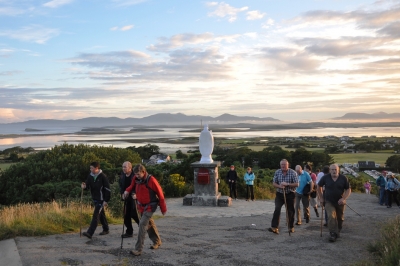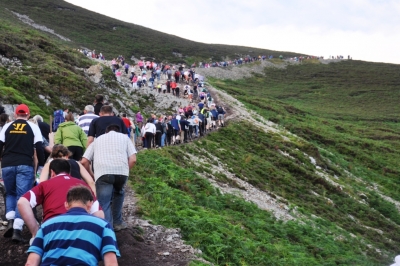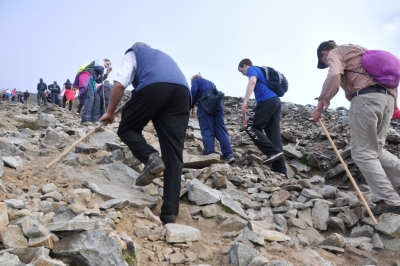Reek Sunday 2013
Reek Sunday, the last Sunday in July, sees several thousand people climb Croagh Patrick on the southern shore of Clew Bay in Mayo. The sheer scale of the event and its links with the ancient and more modern past, mark it out as one of the most distinct events in Ireland. It is a combination of a variety of elements, including the Celtic feast of Lughnasa, Patrician lore, spiritual devotion, personal and familial tradition and the sense of an event. For a historical overview of Croagh Patrick, checkout the post from Pilgrimage in Medieval Ireland.
Although Croagh Patrick is climbed throughout the year, Reek Sunday is a special day. People from all over Ireland travel especially on that day. You are guaranteed to encounter all manner of humanity here. It is also on this day that some of the more religious or spiritual elements come to the fore. My fieldwork involved me engaging with the events, people and landscape of Croagh Patrick throughout Reek Sunday. I started off about 6am walking; however, I made frequent stops to photograph and record events. I spent a few hours on the summit taking everything in and talking to some people and, then, descended slowly, arriving down by 4pm.
This video is an amalgamation of different recordings I made throughout the day. It attempts to give a sense of the movements, sounds and moments that make up the pilgrimage.
One of the most striking aspects of the day is the significant numbers who are climbing at an early hour. While some people still practice the traditional night pilgrimage, the main crowds start arriving from about dawn. When I was walking up after 6am, there were at least several thousand people on the Reek. While most of the world rests on this Sunday morning, the approaching roads, fields being used as car parks and the paths are alive with activity. In a previous post, I have outlined the route and character of the main path leading up from Murrisk.
The steep pathway leading up the Reek proper – Casán Phádraig – is what is associated most frequently with Croagh Patrick. Pilgrims, usually with sticks, struggle up the loose surface, while those descending are moving cautiously, ever conscious of balance. On this day, the path is a stream of activity with hundreds of feet, unsecured stones, encounters and conversations. This audio secording gives as sense of how much is actually going on and how active the path is
The summit is the site of masses all morning with pilgrims gathering on the gable end of the Chapel from where the mass is celebrated; confessions are also available. While acting as a central point of the pilgrimage as a Catholic event, it is also related to the Plenary Indulgence associated with Croagh Patrick. Rounds of the chapel and St Patrick’s bed are practised, with each been circled by pilgrims saying the Rosary. Many others rest, eat and often take photos of the views across Clew Bay. Also, there are usually a number of stalls selling drinks, tea and bars of chocolate (at airport prices!). There is a sense of being separate from the mundane on the mountain. The views allows a wider perspective, with many of the immediate concerns being left behind. This sense is a crucial component of the pilgrimage experience; and, although the summit is so busy there is still a feeling of being removed from everything else
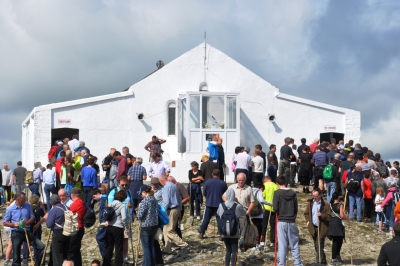
St Patrick’s Chapel on the summit, just after one of the masses (one every half hour between 8am & 2pm). Pilgrims on the left are queueing for Confessions and those on the right for Communion.
A recording of the gospel (The Beatitudes formthe Sermon on the Mount, Matthew 5:3–12) at the 9.30am mass, read by Archbishop Charles John Brown, Apostolic Nuncio to Ireland.
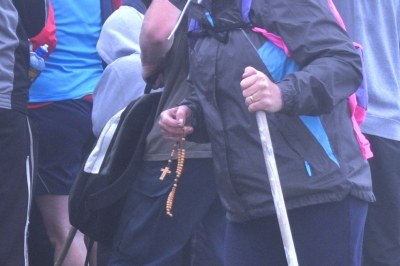
A pilgrim rounding the chapel with their rosary beads. The congregation at mass are in the background.
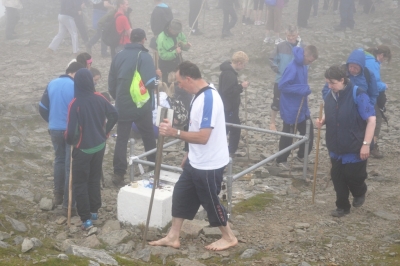
Leaba Phádraig: A number of pilgrims follow the traditional stations of the route by rounding St Patrick’s Bed reciting prayers.
Going down, which is often seen as being more challenging, involves steady footing and heavy use of the stick almost as a third foot. The mountain is known for the camaraderie it encourages in people. Those descending continually assure those coming up that there almost there, some giving slightly unrealistic estimations, possible to bolster confidence and determination. Furthermore, these seems to have been a perennial characteristic of Croagh Patrick with one 1910 commentator, known only as E O’L. writing in The Irish Monthly saying that such assurances were “well calculated to cheer and revive the drooping spirits, such as ” Bravo ! you’re getting on grand, you have only a few hundred yards more to climb,”…” (p.592).
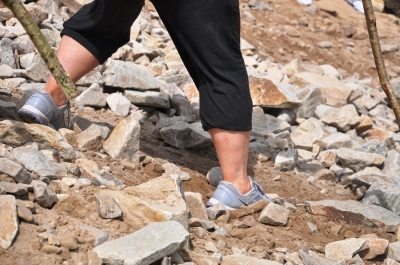
Descending the Casán: going down the steep path on uncertain surfaces is often considered to be the most challening aspect. Here the feet, the means by which the pilgrim engages physically with the mountain, are adjusting to the incline.
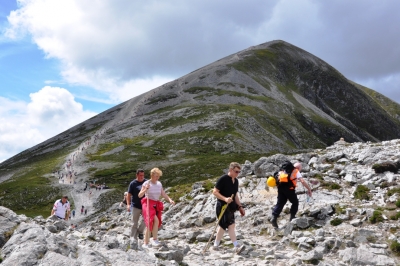
The Reek proper in the early afternoon, the steady flow of pilgrims are evident, animating the path all the way up the peak.
Further down the path one goes the more the everyday world encroaches, as everything gradually becomes closer and more real. Adding to this sensation is the collection of stalls and people at the end of the path. Whether selling or promoting something, they speak to a real world, with concerns beyond the mountain
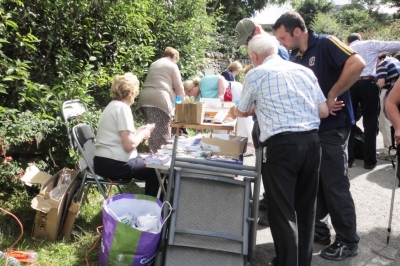
Numerous groups and business set up stalls at the base of the path in Murrisk. While, some are promotion particular causes or denominations, others are selling religious items or food.
This was my second Reek Sunday (both being motivated by my research), but I’ve already grown fond of the day. It has a distinct feel to it and I can understand some of what draws people back year after year. Also, the role played by groups such as volunteer first aiders, stewards, Gardaí, the Air Corps, clergy and local people should be acknowledged.
Suggested Reading:
Hughes, H., 2005. Croagh Patrick: Ireland’s Holy Mountain. The Croagh Patrick Archaeological Committee.
Hughes, H., 2010. Croagh Patrick: a place of pilgrimage, a place of beauty. O’Brien Pub.
O’L., E., 1910. A Pilgrimage to Croagh Patrick: July 31, 1910. The Irish Monthly, 38(448), pp.585–596.
Road to Emmaus staff, 2011. Croagh Patrick: The glorious climb of Ireland’s holy mountain. Road to Emmaus, 12(2), pp.1–45.
